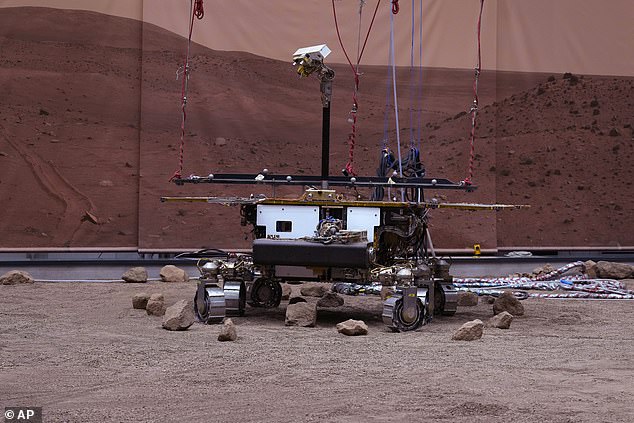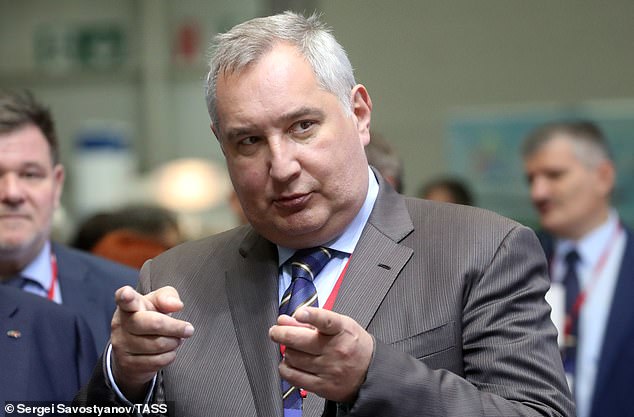
Russia’s war on Ukraine is likely to delay Rosalind Franklin’s upcoming mission to Mars, according to the European Space Agency (ESA).
The European Space Agency, in a statement published on Monday, said it had “fully implemented the sanctions” imposed on Russia by its 22 member states over the armed conflict.
According to the European Space Agency (ESA), the ambitious UK-made Rosalind Franklin rover has become unlikely to launch in 2022 as a result.
The rover is part of the ExoMars mission, a joint project of the European Space Agency and the Russian space agency Roscosmos.
It was due to launch into space in September from southern Kazakhstan and was scheduled to land on Mars in June 2023.

The Rosalind Franklin Mars Rover (pictured here on Mars) was on its way to launch on the Red Planet in September 2022 – but this year’s launch is now ‘highly unlikely’

Rosalind Franklin is a planned robotic Mars rover, which is part of the international ExoMars program led by the European Space Agency and Russia’s Roscosmos. Pictured is Rosalind’s twin on Earth, known as Amalia, successfully leaving the platform simulating the terrain of Mars
Russia designed the “Kazachok” landing craft in which the Rosalind Franklin rover was to be deployed.
at statment The European Space Agency, posted on its website, said it was “assessing the consequences for each of our ongoing programs” implemented in cooperation with Roscosmos, while condemning Russia’s actions.
“We deplore the human toll and the tragic consequences of the war in Ukraine,” the European Space Agency said.
We give absolute priority to making appropriate decisions, not only for the sake of our workforce participating in the programmes, but with full respect for our European values, which have always fundamentally shaped our approach to international cooperation.
In terms of ExoMars continuity, the sanctions and broader context make its launch in 2022 highly unlikely.
In response to the decision, Dmitry Rogozin, Director General of the Russian Space Agency Roscosmos, published his mother tongue to Twitter: “The European Space Agency, despite the Russian grandmother, decided to freeze her ears.”
In the ESA statement, the space agency also said it took note of Roscosmos’ decision to withdraw its workforce for its Soyuz rockets from the European spaceport in Kourou, South America.
Russia’s decision to do so, which Rogozin announced on Saturday, came due to sanctions imposed by Europe.
The future of the International Space Station (ISS) has also been in question, which has been supported by five participating space agencies – including the European Space Agency, the European Space Agency, Roscosmos and NASA – since its inception.

Pictured is Dmitry Rogozin, Director General of the Russian Space Agency Roscosmos. In response to the ESA’s decision, Rogozin posted in his native language on Twitter: “The European Space Agency, regardless of the Russian grandmother, decided to freeze her ears.”

The International Space Station (ISS, pictured), which is 357.5 feet wide and 239.4 feet long, completes a full orbit around Earth once every 90 minutes
There are currently seven astronauts – four from the United States, two from Russia and one from Germany – on the International Space Station.
Rogozin said US sanctions could “destroy our cooperation,” and said the search platform would collapse to the ground without his country’s help.
“If you prevent cooperation with us, who will save the International Space Station from getting out of an uncontrolled orbit and falling on American or European soil?” – Noting that the station does not fly over a large part of Russia, said Rogozin.
However, one space expert said this is unlikely, given that Roscosmos has Russian personnel on board.
“No one wants to put astronauts’ lives at risk through political maneuvering,” John Logsdon, a professor and space analyst at George Washington University, told AFP.
Moreover, regarding the Rosalind Franklin rover, the ESA also said that its director general would “analyze all options and prepare a formal decision on the way forward”.
ExoMars – a joint program between ESA and Roscosmos – actually consists of two missions, one of which has yet to take off.
The first rover, the Trace Gas Orbiter, or TGO, arrived at Mars in 2016 and began its full science mission in 2018.
The TGO was accompanied by the failed Schiaparelli lander, which crashed onto the surface of Mars due to an early launch of a parachute, and is now nothing more than a crusty black speck surrounded by rusty red sand.
The second ExoMars mission consists of a British-made rover called the Rosalind Franklin and the Kazachok surface platform.
Named after the London-born scientist and co-discoverer of the structure of DNA, Rosalind Franklin was scheduled to blast off into space in September 2022 from southern Kazakhstan.
The craft was built by Airbus Defense and Space, at the company’s UK facility in Stevenage, Hertfordshire, and is capable of drilling 6.5 feet (2 meters) below the surface, collecting samples from areas unaffected by radiation.
The rover is the first to honor a female scientist on board its pioneering exploration vehicle.

It is only possible to make a shorter nine-month trip to Mars every two years, which is why the probe could not be launched last year

TGO (pictured here in artist impression) arrived at Mars in 2016 and began its full science mission in 2018
In January, the British Space Agency confirmed that Rosalind Franklin had passed the final round of tests and was on track for a launch to the Red Planet in September.
Understanding the history of water on Mars and whether this allows life to thrive is at the heart of the European Space Agency’s ExoMars missions.
“The rover named Rosalind Franklin will dig two meters deep at the surface to take soil samples, analyze its composition and look for evidence of life buried underground in the past – and possibly even the present,” says the European Space Agency.

“Web maven. Infuriatingly humble beer geek. Bacon fanatic. Typical creator. Music expert.”





More Stories
Scientists confirm that monkeys do not have time to write Shakespeare: ScienceAlert
SpaceX launches 23 Starlink satellites from Florida (video and photos)
A new 3D map reveals strange, glowing filaments surrounding the supernova